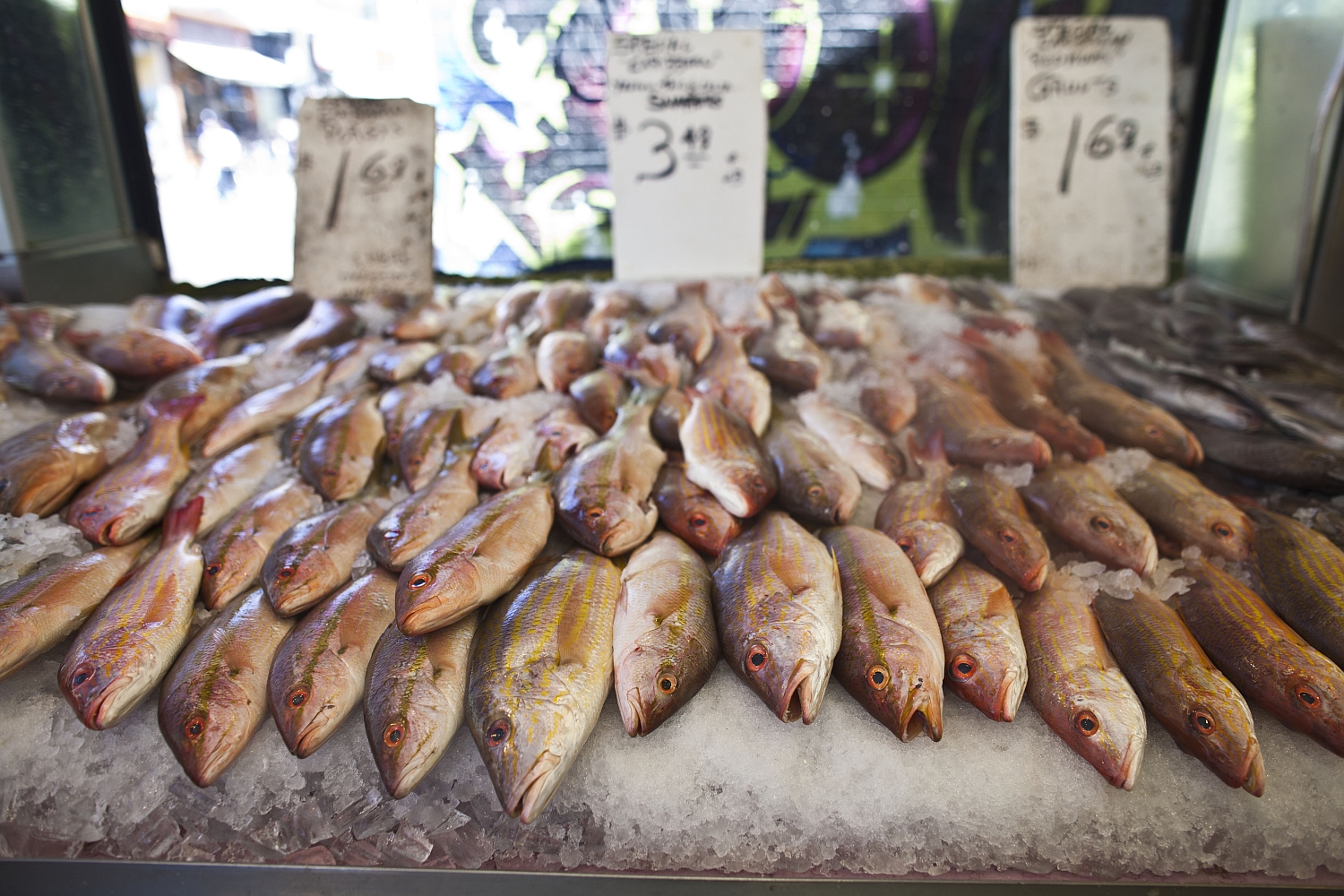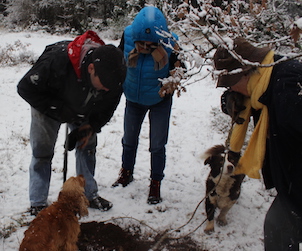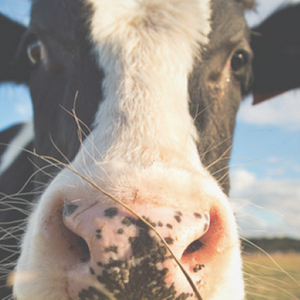by Danielle Dewar
A New York City basement is pumping out a revolutionary and controversial new product, which surprisingly is supported by the State. At New York University’s Brooklyn College, professor Martin P. Schreibman and his colleagues, students and assistants, are developing a solution to ease the world’s fishing crisis and hunger: the Urban Fish Farm.
Aquaculture – the wave of the future for fish farm developments. This is not growing carp in your parent’s bathtub or goldfish in a display tank, this is real fishing for the future… if fishing is going to have a future. As it stands, the world’s natural resources for fish are being hazardously depleted. Currently one sixth of the world’s population consumes fish as a primary protein source. If human beings continue to consume fish in this way, it will not be long before we endanger or worse, extinguish, popular fish varieties like salmon and tuna. In the past we have attempted to solve this growing issue by farming fish within the bounds of natural ecosystems. This has caused its own sizable troubles for those ecosystems invaded and disturbed by the farms – ie. water contamination due to the unnatural abundance of waste produced by the farmed fish, then released into the natural environment. The new innovation, urban Aquaculture farming, where fish are grown in isolation (on land in tanks), could become a clean, safe and manageable way to allow our natural resources to recycle themselves before they are destroyed beyond repair. This will still cater to the tastes and needs of many nations worldwide. The urban system has been engineered in order to compliment rather than supplant commercial fishing, allowing our natural resources just enough of a break to avoid obliteration and eventually return to a balance.
In New York City, where urban aquaculture is just getting going, Dr. Martin Schreibman, of New York University’s Brooklyn College, and his colleagues, hope to see urban farmed fish like his sold locally (to cut down on fish imports) and grown inexpensively to feed the local homeless population of the bustling borough and greater city area. Schreibman and his colleagues are also hopeful that if aquaculture takes off in the city, it could provide jobs and become a very lucrative industry –“a $1.5 billion per year industry in New York City alone”, the professor says.
Which fish are being raised in these vats? Tilapia, primarily. Tilapia are farmed all over the world in many ways. In African nations they are being farmed in villages in man-made ponds where they are the primary foodstuff for the local villagers, providing healthy fats and protein to the malnourished. The fish are also grown in vast fish farms in Asian countries including Thailand for local sale and export. The popular fresh water fish species from the tilapiine cichlid tribe is the high profile fish for urban fish farming. They are not perhaps not quite as popular as salmon and tuna, but tilapia fish are highly disease-resistant and can be safely grown in confined spaces (even safely in moderately filthy conditions) with an unadulterated delicious and nutritious result. The fish also have low to negligible mercury content compared to other popular fish like albacore tuna and swordfish, according to the United States Food and Drug Administration (USFDA), making tilapia brain and nervous system-friendly for those who frequently consume fish. But that’s not all they’re growing.
The scientists at Brooklyn College have fine tuned their aquaculture facilities to such a degree that they have been able to grow fresh water and salt water aquatic species in captivity they never dreamed possible: everything from eels to octopi. They’ve even raised several species of tropical fish and sent them into space on NASA’s Space Shuttle in order to study the effects of hypo-gravity on their sexual reproductive organs! The most recent focus of their attention is on growing horseshoe crab from their eggs to aid in restoration of this species in Jamaica Bay.
Schreibman began working on urban aquaculture with Professor Yonathan Zohar, director of the Center of Marine Biotechnology at the University of Maryland, who created the urban tank concept a few years prior to when Schreibman started his own studies at Brooklyn College. Zohar was using urban aquaculture and gilthead seabream to study how to spawn fish in captivity. The center that Schreibman founded, the Aquatic Research and Environmental Assessment Center (AREAC), received funding from Brooklyn College and a New York State bond in order to form a facility for aquatic research and environmental assessment — focusing on the impact of environment on aquatic organisms. After some time, the facility moved into aquaculture research and now also serves as a teaching facility. Graduates and undergraduates do field work at the centre –currently their focus is on aquaponics –growing fish and plant life together.
The Brooklyn College Aquatic Research and Environmental Assessment Center project has been ongoing since 1998 and has changed focus several times. Its chief purpose has been constant –to grow and study various aquatic species in captivity under varying conditions. They have a number of different tanks used for different species under observation. At present, their major focus is on raising tilapia and learning as much as possible about their sexual reproductive capacity in captivity in order to make a viable new urban industry. There are approximately ten tanks for their tilapia, with sizes ranging from 300 to 1000 gallons of water. Schreibman and his aides are growing roughly ¾ pounds of tilapia per gallon of water. A lot of fish.
Tilapia are omnivores so it is possible to sustain them on various diets. At the centre they have been fed everything from vegetable and cereal based meal, to fish meal to fish oils, to soy and flax meal. They will eat almost anything in their path so they are generally grown in tanks with little to no vegetation as they will likely consume it.
Schreibman has several research objectives for his centre. He is driven to learn as much as possible about how to control the growth of animals in containment. He also aspires to see his work address world famine. He hopes that by growing abundant resources in limited spaces, and using a smaller footprint of water and land in growing food products, technology can truly maximize the yield of this natural product.
The State funding that Schreibman’s project receives has varying guidelines. At the moment New York State is very interested in alternative forms of energy, energy efficiency and conservation of alternative resources. As a result, Scheribman’s project is shifting focus to look more closely at sustainability. When asked how long he predicts his work will continue to be supported, Schreibman replied, “I don’t know. Funding is really difficult to come by these days. But there are always questions to address as long as there is funding available. I hope it goes on forever until we get people fed and teach them to grow their own food…and get them eating locally. I think we’ve got a long way to go.”
The standard opposition to farmed fish is that their nutrients and flavor pale in comparison to wild, and organic fish also available in the city. Schreibman does not share this bleak view of his farmed product. He believes that the stable and clean environment offered in his lab creates a far superior product to that of the average fish farm. Scheibman argues that the proof is in the pudding and that his fish are far more fresh, clean and healthy than the average imported Tilapia available for purchase in New York City. “Those fish travel for weeks and months from Asia before they get to our markets… my fish are sacrificed in the morning and on my dinner plate in the evening.”
Environmentalists have some concerns over the facilities used to grow the fish, specifically the significant amount of energy required to maintain the aquaculture lab facilities – a costly endeavor. Schreibman admits that this side of the process is an issue. The farm facilities need constant observation and maintenance to ensure consistent quality and sanitation. But he also feels there is a trade-off involved. In exchange for power and manual labor, our natural resources will get the break they need to restore and recycle, jobs will be created, and more people will be fed a superior, local, product that they can depend on.
Schreibman’s urban development eliminates some common problems which arise when farms are introduced within natural resources. Because his tanks are contained, their waste does not directly impact local fish populations which often suffer due to the spillover of antibiotics, waste and pesticides common in conventional fish farms. Schreibman’s tanks use a water re-circulation process known as RAS (Re-circulating Aquaculture Systems). The tanks employ a bio-filtration system – a bacteriological process where small filters called bio-balls are used within a filter as places for beneficial bacteria to grow. The tank’s water is re-circulated through these bio-balls which neutralize and trap the tank waste, preventing the potential accumulation of toxic substances in the tank –such as ammonia. The bacteria on the bio-barrels break down ammonia returning clean water back into the tank system. More water is added to the tanks to account for any volume lost in filtration. As tank design has improved, the amount of water added during filtration has been greatly reduced. Schreibman maintains that very little water is added at all to his tanks. “Only ten percent change over per week in our system – some systems have almost zero changeover, making our’s an ideal system, which uses less water and land to grow an ideal product.”
A major benefit of urban fish farming is that it eliminates the threat of escaped farmed fish –a major concern in ecosystems where bred fish compete vigorously for food with the wild fish populations. A hazard of conventional fish farming is an abundance of fish waste, antibiotics, and hormones being released steadily into a natural ecosystem, devastating that system as a result. Martin Schreibman’s fish are grown in such a fine-tuned, clean environment that they need no antibiotics or hormones to be raised. The solid waste produced in Schreibman’s tanks is currently being deposited in the New York City sewer system. At the moment that method is sanitary enough for the volume of waste at issue but if the city were to adopt the new urban farming method, Schreibman feels it would require a manure system to neutralize the waste.
While composing this article, I came across a new book called For Cod and Country by Barton Seaver, a well-known Washington D.C. chef who focused three of his restaurants on sustainable seafood before leaving the line. He served small portions of sustainable species of fish and a vegetable-focused cuisine to make up the rest of the necessary calories in his meals. Seaver now promotes sustainable seafood consumption through a host of high profile organisations including the National Geographic Society, as well as a new television show, In Search of Food, on the Ovation Network. I was very curious to hear his opinion on Aquaculture. He had several positive things to say about it as a tool for saving our natural resources, a tool he felt was being ignored. “Aquaculture has a huge opportunity for profit – we import 80% of our food! Financial markets are remiss to not think of this as a huge opportunity.” When asked if he thought the US Government needed to support project’s like Shreibman’s, Seaver had this to say: “I do! But it is not necessarily the environmental side needing support: aquaculture means job creation, better nutrition for our kids leading to better grades in school. Chambers of commerce, Departments of Education and Defence… all of these cabinets should be interested in supporting and creating this new industry.” Seaver sees great flavor potential in urban farmed fish if they are raised well, but acknowledges that this is not always the case, “some of the farmed fish I’ve experienced have been unpalatable, some shockingly brilliant in taste – and I’ve had everything in between. Urban aquaculture requires talent, perseverance and skill to do well.”
Seaver acknowledges that while urban fish farming has a few drawbacks: “All aquaculture has an opportunity to replace some of the burdens if done correctly. We have to develop systems that take energy and water into account [and] keeping jobs for wild fisherman in mind. Urban aquaculture, in particular, is a great opportunity as it makes Omega 3s available to people unable to access wild coastal fish. It is an opportunity to answer some great social inequality issues that arise around seafood as well.” The most serious concern he has about adopting urban fish farming as a long term solution to the fishing crisis is that, “it has the opportunity to further distance our relationship with wild fisherman. Fisherman deserve as much protection as fish. One danger is we further the disconnect between ourselves and our fishing communities.” But overall, Seaver still thinks the adoption of urban aquaculture is a positive development in the search for the resolution to the fishing crisis. “Urban aquaculture could be part of a long term solution. There is no silver bullet for the fishing crisis… it should be lauded and welcomed as one in a host of tools that we should be pursuing.”
Exactly how much energy and money would be required to run city wide fish farms has yet to be determined, and is a guess Professor Martin Schreibman is hesitant to make. There are potentially many factors to consider before putting such plans into action which is exactly what Schreibman’s team is starting to focus on –drafting business plans for future projects in the city. Still, despite the haziness of some details, Schreibman is confident that Urban Aquaculture is the necessary future for fishing. He is aware that there is a strong push for Ocean Aquaculture — where vast farms are dropped into the middle of oceans — but sees it as the wrong direction to turn. The negatives are the same as those of conventional fish farms which he hopes to resolve with urban Aquaculture –an inability to track lost animals into the wild; pollution from large accumulations of fish waste; and toxicity due to high level of hormones and antibiotics present in the hazardous waste. He sees no sound alternatives to his system. For him, it is the only way.
 When she is not working or drumming, Danielle Dewar is a freelance Toronto food writer with interests ranging from sustainability to food culture to food science and politics. She has apprenticed a pastry chef in a reputable Toronto patisserie, as well as ran her own vegan and gluten free baking company. She has two personal blogs devoted to food, The Daily Nibbler and her latest work in progress devoted to sustainable food and love, Plenty of Figs where readers can learn about food and love throughout history, aphrodisiacs, and even send in their own tales of love and cooking to be published.
When she is not working or drumming, Danielle Dewar is a freelance Toronto food writer with interests ranging from sustainability to food culture to food science and politics. She has apprenticed a pastry chef in a reputable Toronto patisserie, as well as ran her own vegan and gluten free baking company. She has two personal blogs devoted to food, The Daily Nibbler and her latest work in progress devoted to sustainable food and love, Plenty of Figs where readers can learn about food and love throughout history, aphrodisiacs, and even send in their own tales of love and cooking to be published.









Thank you for writing about this, Danielle.
I wonder if there are small-scale aquaculture developments going on, as opposed to what seems to be this industrial-scale one. Perhaps tilapia, or other fish, are suitable for smaller-scale urban farming (again, more on a neighbourhood or community scale).
Hi Joanne,
I believe there is some small scale aquaculture, I’ve heard about it taking place in NYC actually.
Thanks for your comment! Take care,
Danielle
I wonder if Schreibman will take the next step, and make use of the “solid waste” instead of finding a way to dispose of it. Aquaponics seem like a logical next step.